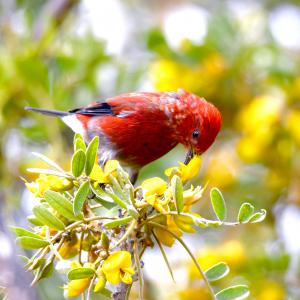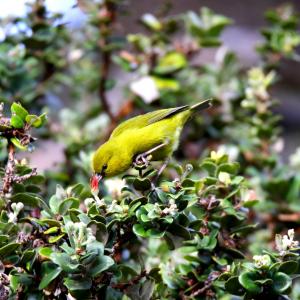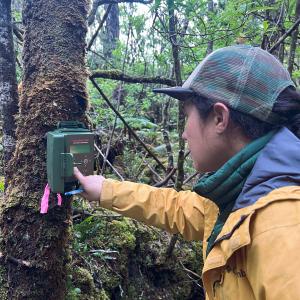UH researchers use AI, Hawaiian chant to save native birds
University of Hawaiʻi at HiloLink to video and sound (details below): https://go.hawaii.edu/c8b
Researchers at the University of Hawaiʻi at Hilo are blending artificial intelligence (AI) and culture to help protect some of the state’s most precious native manu (birds). Many of Hawaiʻi’s forest birds are facing extinction, and UH Hilo biology professor Patrick Hart is employing a mix of high-tech tools and Native Hawaiian traditions to support their remaining populations.
Hart’s research, funded by the Pacific Islands Climate Adaptation Science Center, uses AI to monitor bird populations in remote forests on Hawaiʻi Island. By placing acoustic recorders in the forest, Hart’s team captures massive amounts of bird sound to understand where different species are and how they’re doing. Birds use sound as a way to keep track of other birds.
“It is becoming increasingly important to develop landscape-scale management tools to help prevent the decline and extinction of Hawaiian birds,” said Hart, who founded UH Hilo’s Listening Observatory for Hawaiian Ecosystems or LOHE Lab, where data is analyzed. “But, in order for it to be effective, we need better info about how all of the different species are doing and exactly where they are.”
New AI algorithm
This past year, Hart has worked with Google, to develop a new algorithm, “Perch,” designed specifically for recognizing Hawaiian bird songs. With this new technology Perch can identify the unique sounds of Hawaiian birds with limited data, allowing Hart and his team to accurately estimate bird numbers across large areas.
“Hawaiian birds, in particular, are variable in what they say to each other, which is one reason why it has been so hard to train algorithms to automatically detect the songs and calls of these birds,” explained Hart.
Oli composition
In a parallel effort, Hart is collaborating with ʻĀhuimanu, a group dedicated to native bird conservation, to create a special oli (chant) that uplifts Hawaiian birds. The oli, led by cultural practitioner Kekuhi Kanahele Keali‘ikanaka‘oleohaililani, connects each bird to thriving elements in nature to promote balance and resilience.
“The mele recalls and reaffirms the relationships between ourselves, the birds, and the other aspects of the environment,” explained ʻĀhuimanu member Noah Gomes.
Critically endangered
2024 marks Makahiki O Nā Manu Nahele: Year of the Forest Birds. Of the 84 Hawaiian forest bird species known from observation and fossil records, 58 have vanished forever. Today, 24 of the remaining 26 species are endangered, with statuses ranging from “vulnerable” to “critically endangered.” Four honeycreeper species—ʻakikiki, ʻakekeʻe, kiwikiu and ʻākohekohe—face a high risk of extinction within the next decade if significant conservation measures are not taken.
Link to video and sound (details below): https://go.hawaii.edu/c8b
B-ROLL: (1:45)
:00-1:22 Native Hawaiian birds, UH Hilo researchers
1:23 Oli featuring UH Hilo researchers, cultural practitioners
1:36-1:43 Wide of Maunakea
SOUNDBITES:
Patrick Hart/Biology Professor, UH Hilo (12 seconds)
“We’re just at the point of being able to rapidly analyze huge amounts of soundscape data to answer questions that could not be answered until now.”
Hart (18 seconds)
“We’re using sound now to evaluate the effectiveness of these mosquito control techniques to see if we can determine if there’s been changes in density and abundance of birds like the ʻākohekohe, the kiwikiu.”
Hart (15 seconds) on challenges when it comes to native hawaiian birds
“Just has an incredible diversity of syllables and notes and different songs in their repertoire. So it makes it more difficult to train AI to recognize birdsong when they’re so variable.”
Hart (18 seconds)
“We have these really close cultural connections that as the birds have declined over time some of these connections have been lost and so the ʻĀhuimanu group is really devoted to reestablishing some of those connections through the creation of new oli.”



